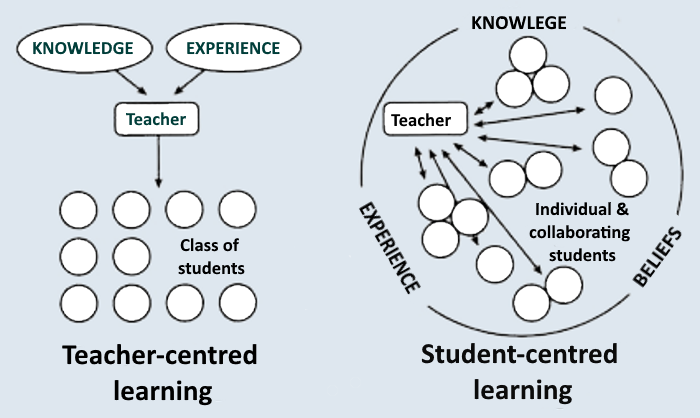| Ask us |
Tell us |
Student-centered learning
"... what the student does is actually more important in determining what is learned than what the teacher does." Thomas Shuell
One of the most effective ways to optimise how and how much students actually learn from a teaching activity is to use student-centered learning strategies, which are based on the theories of constructivism.
Most modern tertiary institutions actively practice teaching which encourages students to take an active role in creating the learning and assessment processes (or say they do, anyway)
Student-centered learning strategies shift the focus of an activity from the teacher to the students. They're very relevant to tertiary and professional education, because they foster motivation and incentive to learn. These types of approaches emphasise the students' interests, abilities and learning styles.
If the teacher is a facilitator, guiding the students, rather than an instructor, giving them directions, then that teacher is allowing the learners themselves to take an active part in deciding what they learn, how they learn, and how they can evaluate what they have learnt.
The aim is for learners to take more responsibility for their learning, and 'own' it, rather than just sitting waiting for the teacher to 'fill them up' with knowledge.
There is evidence that student-centered learning in university helps students to become independent problem solvers, and improves their critical and reflective thinking. It also increases their own confidence in their understanding and their skills.
The input which the students have into their learning also has implications for assessment. Students will be more involved in deciding how to evaluate and demonstrate their learning.
Putting it into practice
Learning contracts are mutual agreements between teachers and students which state explicitly what a learner will do to achieve specific learning outcomes, and how their learning will be measured and evaluated.
They foster an increased responsibility for their own learning. Contracts can include learning expectations, learning resources, learning experiences, documentation and other information such as designated evaluators, evaluation criteria and timelines.
Source: Teaching Strategies Promoting Active Learning in Healthcare Education
Interesting resources
Azer, S 2013, Making sense of clinical teaching: A hands-on guide to success, Boca Raton, CRC Press/Taylor & Francis.
Bradshaw, M & Lowenstein, A 2014, Innovative teaching strategies in nursing and related health professions, Jones and Bartlett Learning.


